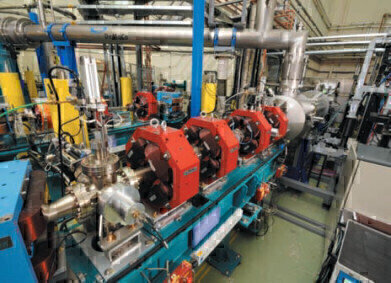News & Views
Breakthrough in the Development of a Diagnostic Test for Oesophageal Cancer
Apr 11 2012
A team of scientists, led by the University of Liverpool, has made a major advance in the development of a diagnostic test for oesophageal cancer, which affects around 8000 people every year in the UK. Research carried out by Professor Peter Weightman and his team has centred on studies of patients with a precursor condition called Barrett's Oesophagus who patients are more at risk of developing this form of cancer and are regularly monitored to detect changes in their condition.
By using the extremely intense source of infrared light (the InfraRed Free Electron Laser) at the pioneering ALICE accelerator at STFC's Daresbury Laboratory, the scientists have been able to image and carry out a blind study of historical endoscopic samples from patients with Barrett's Oesophagus and, by detecting changes that took place in the samples, have developed a diagnostic test for the disease.
Minister for Universities and Science David Willetts said: “It’s incredibly impressive that the UK’s leading physics research can bring benefits for our health and wellbeing, as well as telling us more about the world around us. This work has the potential to save lives and revolutionise the diagnosis and treatment of esophageal cancer. It also demonstrates the value of the Government’s investment in the Daresbury Laboratory. I wish the researchers well in taking these findings through to clinical use.
” Professor Weightman said: "Early diagnosis is the most important factor for improving the prognosis for patients with oesophageal cancer. But it is extremely hard to diagnose accurately - a false negative test can be fatal, whereas a false positive means unnecessary major surgery.
Eventually we hope to develop a diagnostic test that can be used in an endoscope. The most promising approach may be to develop a test using the intense terahertz light also generated by ALICE. ALICE is Europe's most intense band source of terahertz light and the only one in the world equipped with a tissue culture facility for research on cancer. This would lead to much cheaper and more efficient diagnosis of the disease. However this development is some way off."
Digital Edition
Lab Asia 31.2 April 2024
April 2024
In This Edition Chromatography Articles - Approaches to troubleshooting an SPE method for the analysis of oligonucleotides (pt i) - High-precision liquid flow processes demand full fluidic c...
View all digital editions
Events
May 05 2024 Seville, Spain
InformEx Zone at CPhl North America
May 07 2024 Pennsylvania, PA, USA
May 14 2024 Oklahoma City, OK, USA
May 15 2024 Birmingham, UK
May 21 2024 Lagos, Nigeria










.jpg)







